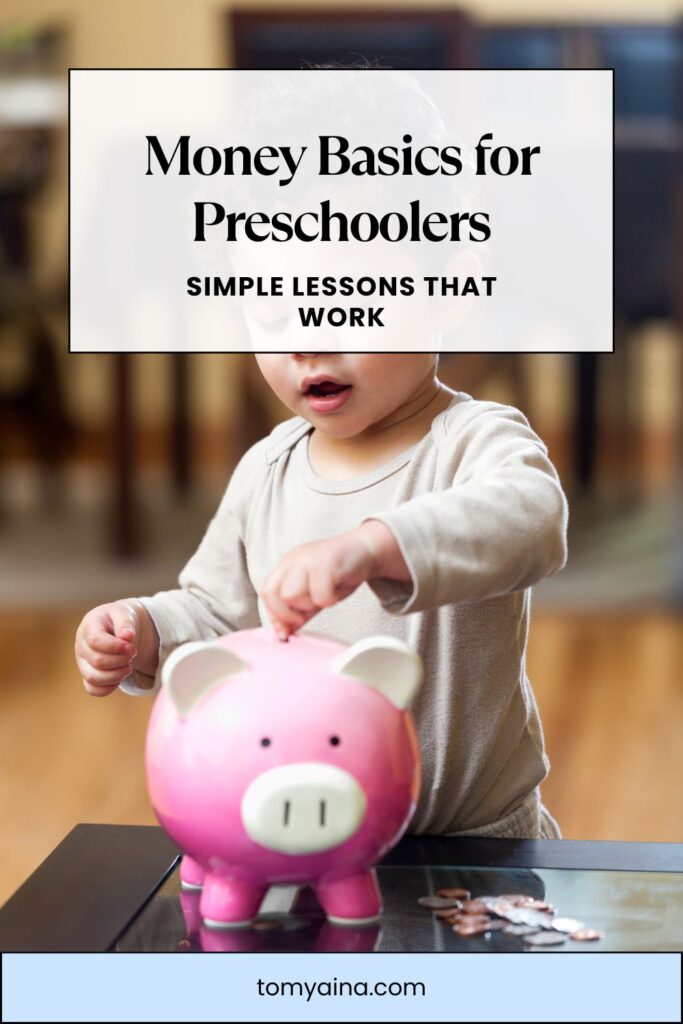The other day, my son was playing with my wallet. He spotted some coins and said, “Mom, let’s save this in the piggy bank so it can go to the bank.”
I was surprised, but also thrilled! We had talked about saving before, but this was the first time I saw him connect the dots on his own.

That moment reminded me: kids can learn about money earlier than we think.
If you are wondering, “But is it not too difficult for young children to understand the value of money?” the answer is no. With simple, age-appropriate money lessons, you can give your kids a strong foundation in financial responsibility.
Here are the best ways to start teaching kids about money.
Start with Numbers and Basic Money Concepts
Before children can understand money, they need to recognize numbers and match them to different values. Counting apples, stacking blocks, or sorting coins helps kids connect numbers with real quantities.
In our home, we focused on number identification and also reading first. For inspiration, check out my posts on How to Help Kids Identify Numbers and I Want My Child to Read But I Don’t Know How: Here’s What Worked for Us. Both skills form a solid foundation for financial education.
Use a Piggy Bank
A piggy bank is a simple way to introduce saving habits. My son used to open his piggy bank constantly, so I explained that it “keeps the money safe until it goes to the real bank.” Now he looks forward to putting money in it.
Try clear jars labeled Save, Spend, Share. Clear jars are a fun visual aid—they help kids literally see their money grow.

Modern twist: Some families love programmable piggy banks that only open with a code. We actually use the ATM-style programmable piggy bank in our home. You enter a code, and it pulls the money in just like a real ATM. My son absolutely loves using it—it makes saving feel fun and interactive. You can check it out here.
Practice Shopping With a Budget
Take your child on a money adventure at the dollar store:
- Give them a set amount of money (like $5).
- Let them choose what to buy—within the budget.
- Show them how to stick to the list.

Some parents use picture lists for younger children. If your child can read, let them write the shopping list.
This builds discipline: “We only buy what is on the list.”
Opportunity cost tip: When my son Ari goes over his $5 limit, I say, “Ari, you’ve picked too much. Let’s choose one thing and put the others back.” This introduces opportunity costs, while also sneaking in early math practice with addition and subtraction.
Teach Waiting and Planning (Savings Goals)
Not everything is “now.” When my son asks for something, I say: “Not this month, maybe in November.”
He often follows up with, “What month are we in now?” — and that sparks a fun mini-lesson. We use the opportunity to go over months of the year while also talking about saving and waiting.
Trust me, these are simple, natural ways to introduce and solidify concepts for kids: patience, planning, and even time awareness. It shows them that sometimes we wait to reach a savings goal, and in the process, they learn how the calendar works too.
Explain Gifts and Saving (Save, Spend, Share)
When children receive money as a gift, it’s a perfect chance to explain saving. Encourage them to put part of it away, instead of spending everything at once.
A Save, Spend, Share system is a fun way to show the value of money and build good money habits from an early age.
Be Honest About Work and Money
Sometimes my son says, “Mom, I don’t want you to work.”
I use that moment to explain:
- Why I work.
- How work helps me earn money.
- That money isn’t magic—it’s exchanged for effort.

This builds respect for financial responsibility and shows kids that personal finance starts with making wise choices.
Teach Generosity (Jesus Money)
We recently introduced offering money at church. My son calls it “Jesus money.”
It’s a small lesson, but powerful: money is not just for us—it can also be used to give. Kids learn early that financial education includes generosity, not just saving and spending.
Final Thoughts: Why Start Money Basics at a Young Age
At this early age, children don’t need to understand credit cards, debit cards, or mutual funds. For now, I believe preschoolers should focus on simple tools like piggy banks and clear jars. These give them a hands-on way to manage their own money and see the value of saving.
With time, and with the help of age-appropriate books and resources, we can gradually start introducing bigger financial concepts. Trust me, I’ll be sharing some of these resources here as my son grows, so we can take this journey together.
As children get older, these lessons can expand to include:
- Opening a savings account at a local bank.
- Learning to use a debit card responsibly.
- Setting bigger financial goals, like saving for a new toy, planning for college, or even understanding investments.
These lessons evolve as your child moves from preschooler to older children. For now, the focus is on building a strong foundation, the basics of money management that will shape their financial future.
Kids learn more from what they see than what they hear. Starting money basics at a young age makes financial literacy lessons natural, not forced.
By the time they are older children ready for allowances or even their first job, they will already understand saving, spending, waiting, and giving—laying a strong foundation for lifelong financial success.

Great tips for the young people in my house! And the ATM bank sounds like a super fun way to make learning financial literacy easy too.